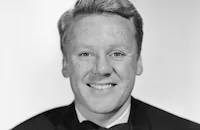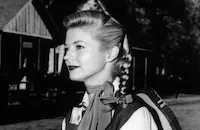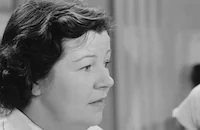The Romance of Rosy Ridge

Brief Synopsis
Cast & Crew
Roy Rowland
Van Johnson
Thomas Mitchell
Janet Leigh
Marshall Thompson
Selena Royle
Film Details
Technical Specs

Synopsis
In 1865, at the end of the Civil War, many residents of Missouri, a border state, remain divided by their allegiances. In Rosy Ridge, in the Ozark mountain region, neighbors still examine the color of a man's britches to determine on which side he fought. Memories of the brutal war are being kept alive in Rosy Ridge by a recent rash of mysterious barn-burnings in the area. The night raids appear to be indiscriminate, as barns of both Confederate and Union sympathizers are being set ablaze. The most recent victim of the night raids, Gill MacBean, an impoverished war veteran who fought for the South, becomes embittered by the attacks and vows revenge. At the urging of his wife Sairy, however, Gill forsakes vengeance, and instead devotes himself to rebuilding his home. One night, the MacBean family takes in a passing young vagrant, named Henry Carson, whose britches are so faded that Gill is unable to determine his loyalties. The amiable harmonica-playing visitor is given food and shelter by the MacBeans, and it is only after the passing of many days that Gill discovers that Henry is a Northerner. By that time, though, Henry has won the admiration of the MacBeans, especially that of Gill's daughter, Lissy Anne, who has fallen in love with the guest. Believing that the time has come for the residents of Rosy Ridge to bury their differences, Henry proposes a town party in which everyone, regardless of their allegiance, will be invited. The party, organized by storekeeper Cal Baggett, gets off to a bad start when one of the guests refuses to dance to a Northern song. The tension mounts when the guests divide into two groups, the Northerners on one side, the Southerners on the other. Though he initially finds it difficult to choose sides, Henry eventually chooses to align himself with the Northerners, a move that shocks the MacBeans. A brawl ensues, after which Gill refuses to allow Henry to return to his home. Lissy Anne, heartbroken by her father's decision, leaves Rosy Ridge with Henry. Vowing to bring his daughter home, Gill sets out with his rifle and bloodhounds to find her. Gill brings Henry and Lissy Anne home, after which Henry confesses that he fought alongside Ben, Gill's son. Henry tells the MacBeans that Ben, who was fatally wounded in a battle and died in his arms, made him promise that he would go to Rosy Ridge and help his family work the farm. Gill, moved to tears by Henry's confession, invites the young man to stay and gives his blessing to marry Lissy Anne.

Director

Roy Rowland
Cast

Van Johnson

Thomas Mitchell

Janet Leigh

Marshall Thompson

Selena Royle

Charles Dingle

Dean Stockwell

Guy Kibbee

Elisabeth Risdon

Jim Davis
Russell Simpson
O. Z. Whitehead
James Bell
Joyce Arling
William Bishop

Paul Langton
Clarke Hardwicke
William Roberts
Bruce Cowling
Constance Weiler
Jane Green

Robert Strickland
Guy Stockwell
Ethel Tobin

Gail Davis
Wanda Cantlon

Marie Windsor
Eloise Hardt
Buddy Roosevelt
Sarah Edwards
Ann Lace
Jack Clifford
Kermit Maynard
I. Stanford Jolley
Lou Mason
Don Lewis
Brick Sullivan
John Phipps
Robert E. O'connor
Mitchell Lewis
Del Henderson
Redmond Doms
Henry Sylvester
Sam Ash
Frank Pharr
Bob Thom
Tom Pilkington
Eddie Dunn

Robert Morley
George Magrill
Sid D'albrook
Billy Engle
Jack Sterling
Fred Kruger
Gene Coogan
Mahlon Hamilton
Skeets Noyes
Dick Rush
Jerry Schumacher
Lew Smith
Rhea Mitchell

May Mcavoy
Barbara Billingsley
Erin O'kelly
Franz Dorfler
Catherine Moore
Rose Langdon
Florence Howard

Naomi Childers

Margaret Bert
Polly Bailey
Dorothy Vernon
Vangie Beilby
Lucille Curtis
Crew
Lewis Allan
Peter Ballbusch
George Bassman
George Bassman
Lester Cole
Jack Cummings
Jack Dawn
Jack Donohue
Richard Duce
Cedric Gibbons
Horace Hough
Eddie Imazu
Irene
Elliot Morgan
Warren Newcombe
Earl Robinson
Douglas Shearer
Art Smith
Valles
Sidney Wagner
Edwin B. Willis
Ralph E. Winters

Photo Collections
Videos
Movie Clip



Trailer
Promo
Film Details
Technical Specs

Articles
The Romance of Rosy Ridge
Leigh had very little acting experience but her test went well, which she partly attributed to Selena Royle being so kind to her. The following week she was called into her acting coach's office and told "the rushes had been excellent; the final cut was outstanding; the test would definitely be an asset to her future. But, although she didn't know for sure, it didn't appear that she would be doing the picture." Leigh, barely nineteen, was disappointed and went into the bathroom "where she could safely give vent to her emotions, indulge in a little self-pity." Someone started pounding on the door. She opened it and was hurried back to her coach's office where director Roy Rowland and producer Jack Cummings were waiting to tell her that she had won the part. "She burst into tears. She wasn't alone - Miss Burns was crying, and even Mr. Cummings and Mr. Rowland and Mr. Friedman were misty. They all started hugging and crying and laughing. Then level heads took command. She had to get to wardrobe immediately, if not sooner. All of her costumes had to be made and be ready to ship in two weeks. The company would locate in Santa Cruz for three months of exterior shooting and then return to the studio and complete the interiors...Jeanette had sunk back down in the chair and had started to sob again. 'For Pete's sake, now what's the matter?' 'I c-can't go. I can't d-d-do the picture.' 'In heaven's name, why?' 'I can't afford to stay in a hotel or pay tr-train fare.' She wailed even more violently. They gazed at her in utter disbelief, completely dumbfounded. How could she be this innocent, this naive? She really was Lissy Anne MacBean, the innocent heroine of The Romance of Rosy Ridge.
Leigh was immediately sent to the wardrobe department to be fitted for her costumes when "there was a knock and then a figure burst into the room. Holy cow, it was Van Johnson! Looking just like - Van Johnson! Reddish-blond hair, freckles, and sporting the famous boyish grin. Jeanette was absolutely tongue-tied; her prince, her dream man, was standing next to her. 'Saw your test - you were wonderful. Congratulations! Be seeing you soon' and he was off. She had barely stammered out a how-do-you-do."
The MGM publicity machine went into overdrive announcing their new actress and photographed her standing with Johnson and her 'discoverer' Norma Shearer. Leigh wrote "When the last shutter had clicked, Jeanette was told what her new name would be. Mr. Johnson had thought of it. She imagined how many girls in this country would have just loved to be named by Van Johnson, and she was the one out of millions. He had shortened Jeanette to Janet, and because the movie dealt with the Civil War, he thought of Lee (the General), but spelled it Leigh. 'Oh no! Vivien Leigh is already a great actress.' 'And Van Heflin is already a great actor.' He went on, 'Miss Vivien Leigh pronounces it 'Lay', we'll pronounce it as 'Lee.' And so it was. And Janet Leigh was born."
Leigh's first day on the set was physically painful. She was supposed to run across a field "yelling, 'Ben's a-comin' home! Maw! Paw!' There was a large reflector on a broad stand in the vicinity. When I started running, and I was pretty fast, I hit the foot of the stand and did a head-over-heels spread-eagle flop. Mr. Rowland thought I was a goner on the very first shot. And it wasn't over yet. Later one of Lissy Anne's chores was to milk the family cow. I had never come in contact with a cow in my entire young life. The cowboy in charge of the animals showed me the procedure. Bessie wasn't pleased with my hesitant hands and became restless. She then proceeded to step on my foot - all fifteen hundred pounds of her. It seemed not to be my day. But it was! It was a glorious day! It was a perfect day! It was a never-to-be-forgotten day! It was the first day of shooting on my first movie. And I loved it, every minute of it. I loved being Lissy Anne MacBean. I loved the camaraderie of everyone on the set. I loved the team effort. I even loved Bessie."
Audience reaction to both The Romance of Rosy Ridge and Janet Leigh was favorable and she was signed to a long-term contract with MGM.
Producer: Jack Cummings
Director: Roy Rowland
Screenplay: Lester Cole, MacKinlay Kantor (story)
Cinematography: Sidney Wagner
Film Editing: Ralph E. Winters
Art Direction: Richard Duce, Cedric Gibbons, Eddie Imazu
Music: Lewis Allen, George Bassman, Earl Robinson
Cast: Van Johnson (Henry Carson), Thomas Mitchell (Gill MacBean), Janet Leigh (Lissy Anne MacBean), Marshall Thompson (Ben MacBean), Selena Royle (Sairy MacBean), Charles Dingle (John Dessark), Dean Stockwell (Andrew MacBean), Guy Kibbee (Cal Baggett).
BW-106m. Closed captioning.
by Lorraine LoBianco
Sources:
Janet Leigh, "There Really Was A Hollywood: An Autobiography."

The Romance of Rosy Ridge
TCM Remembers Van Johnson - Important Schedule Change on TCM In Honor To Salute VAN JOHNSON
The new schedule for the evening of Tuesday, December 23rd will be:
8:00 PM In the Good Old Summertime
9:45 PM A Guy Named Joe
12:30 AM Thirty Seconds Over Tokyo
2:30 AM The Last Time I Saw Paris
4:30 AM Thrill of a Romance
Van Johnson (1916-2008)
Van Johnson, the boyish leading man whose clean cut, All-American appeal made him a top box-office draw for MGM during World War II, died on December 12 in Nyack, New York of natural causes. He was 92.
He was born Charles Van Dell Johnson on August 25, 1916, in Newport, Rhode Island. By his own account, his early childhood wasn't a stable one. His mother abandoned him when he was just three and his Swedish-born father offered little consolation or nurturing while he was growing up. Not surprisingly, Johnson found solace in singing and dancing lessons, and throughout his adolescence, he longed for a life in show business. After graduating high school in 1934, he relocated to New York City and was soon performing as a chorus boy on Broadway in shows such as New Faces of 1936 and eventually as an understudy in Rodgers and Hart's musical, Too Many Girls in 1939.
Johnson eventually made his way to Hollywood and landed an unbilled debut in the film version of Too Many Girls (1940). By 1941, he signed a brief contract with Warner Bros., but it only earned him a lead in a "B" programmer Murder in the Big House (1941); his contract soon expired and he was dropped by the studio. Johnson was on his way back to New York, but as luck would have it - in the truest Hollywood sense - friends Lucille Ball and Desi Arnaz introduced him to Billy Grady, a lead talent scout at MGM, which was currently Ball's new studio. Johnson was signed up and almost immediately MGM had a star on its hands.
It might have been slow going at first, with Johnson playing able support in films such as Dr. Gillespie's New Assistant and The War Against Mrs. Hadley (both 1942). By 1943 the studio capitalized on his broad smile and freckles and starred him in two of the studio's biggest hits: A Guy Named Joe and The Human Comedy. Those two films transformed him into a boxoffice draw with a huge following, particularly among teenage girls. A near fatal car accident that same year only accentuated the loyalty of his fans, and his 4-F status as the result of that accident created an opportunity for him when so many other leading actors of the era (James Stewart, Clark Gable) were off to war. Johnson was quickly promoted as MGM'sleading man in war heroics and sweet romancers on the big screen: The White Cliffs of Dover, Thirty Seconds Over Tokyo (both 1944), Thrill of a Romance, the episodic Week-End at the Waldorf (both 1945), and a musical remake of Libeled Lady entitled Easy to Wed (1946).
Hits though these were, it wasn't until after the war that Johnson began to receive more dramatic parts and better material such as supporting Katharine Hepburn and Spencer Tracy in the political farce State of the Union (1948). other significant roles included the well-modulated noir thriller The Scene of the Crime, the grim war spectacle Battleground (both 1949), the moving domestic drama Invitation (1952) in which he played a man who is paid to marry a woman (Dorothy McGuire) by her father. Before he left MGM, he closed his career out in fine form with the sweeping musical Brigadoon, co-starring Gene Kelly and Cyd Charisse; and the lilting soaper The Last Time I Saw Paris (both 1954) with Elizabeth Taylor.
After he left MGM, the parts that came Johnson's way weren't as varied, but he had his moments in The Caine Mutiny (1954), the beguiling romance drama Miracle in the Rain (1956) with Jane Wyman; and his lead performance in one of the first successful made for-TV-movies The Pied Piper of Hamelin (1957). By the '60s, Johnson returned to the stage, and played the title role in London's West End production of The Music Man. He then returned to Broadway in the drama Come on Strong. He still had a few good supporting parts, most notably as Debbie Reynolds' suitor in Norman Lear's scathing satire on marital differences Divorce American Style (1967); and television welcomed his presence on many popular shows in the '70s and '80s such as Maude, Fantasy Island, The Love Boat and of course Murder She Wrote. There was one last graceful cameo in Woody Allen's The Purple Rose of Cairo (1985), yet for the most remainder of his career, Johnson worked mainly on the dinner theater circuit before retiring from showbiz completely by the mid-90s. He is survived by a daughter, Schuyler.
by Michael T. Toole
TCM Remembers Van Johnson - Important Schedule Change on TCM In Honor To Salute VAN JOHNSON
Quotes
Trivia
Notes
Working titles for this film were The Yankee and The Night Raiders. The MacKinlay Kantor novel on which this film is based was first published as a serialized story in The Saturday Evening Post in three issues from 5 June through June 19, 1937. In the film, the character of "Ben" is shown in flashback as "Henry" describes their meeting. An August 1945 Hollywood Reporter news item notes that King Vidor was originally set to direct the picture. According to a June 1946 Hollywood Reporter news item, first James Stewart and then Gregory Peck were set to star in the film.
The picture marked the screen debut of Janet Leigh (1927-2004), who was born Jeanette Helen Morrison. Various August 1946 Hollywood Reporter news items indicate that Leigh's name, at the time M-G-M announced her for a role, was Jeanette Reems. Another Hollywood Reporter news item announced that M-G-M had changed Leigh's name to Ann West. According to Hollywood Reporter, Leigh was discovered by Norma Shearer, who recommended her to producer Jack Cummings. An August 1947 New York Times article notes that Shearer discovered a picture of Leigh while thumbing through a family photo album at a northern California ski lodge, where Shearer was vacationing. Shearer reportedly showed the photograph of Leigh, the lodgekeeper's daugher, to M-G-M executives, and they immediately sent for her. Leigh, who had never acted, danced or sang professionally, was signed to the leading role only three weeks after arriving in Hollywood.
According to Hollywood Reporter, most of the film was shot on location in Santa Cruz, CA, with some scenes filmed in Sonora and Kennedy Meadows, CA. The film marked the final picture of M-G-M cameraman Sidney Wagner, who died of a stroke on July 7, 1947. Wagner was working on the film The Bride Goes Wild at the time of his death.

Miscellaneous Notes
Released in United States Summer August 1947
Released in United States Summer August 1947















